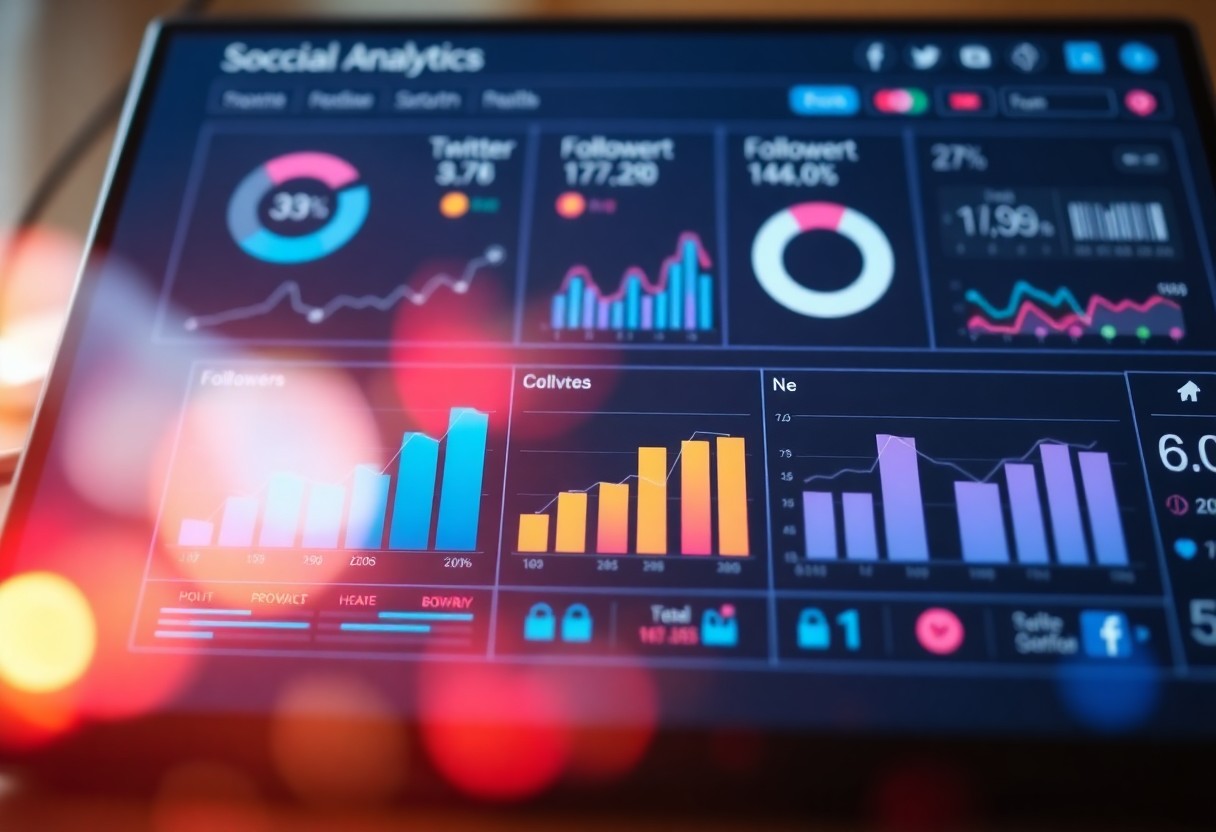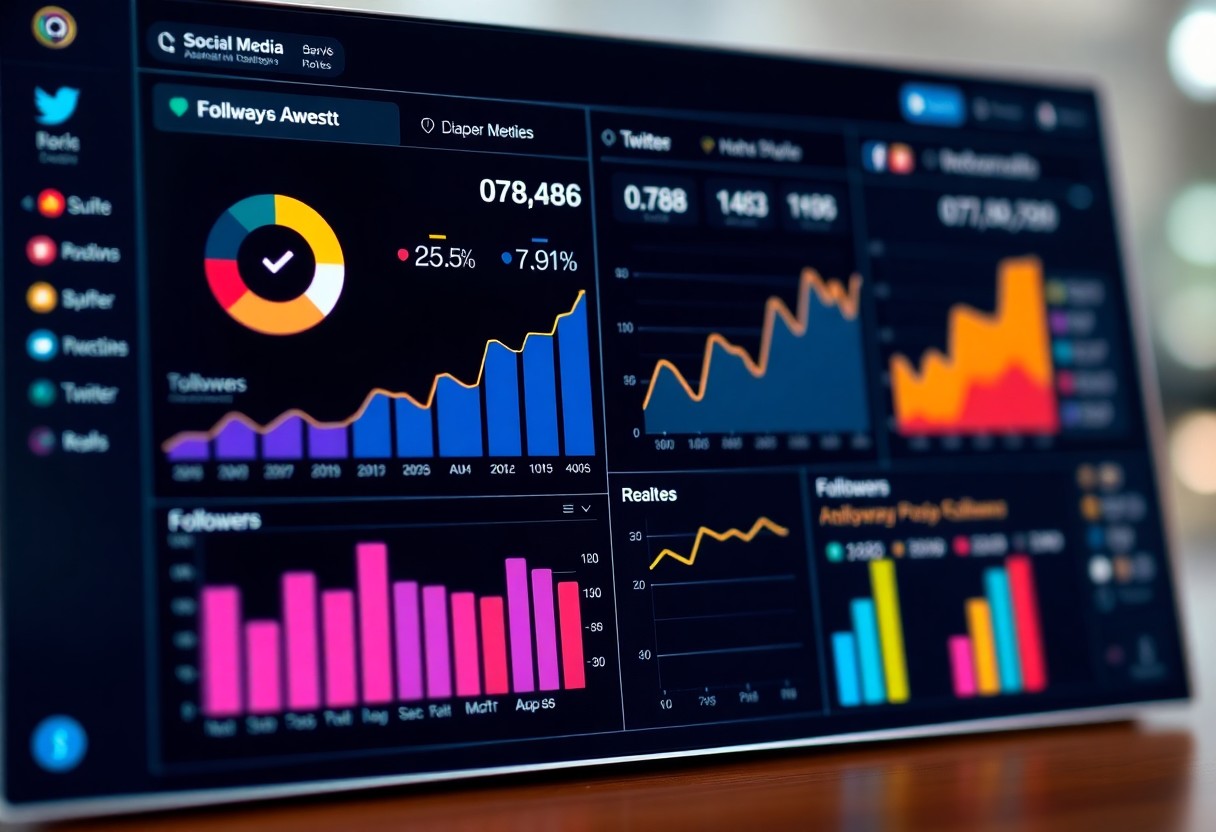Many brands are missing out on transformative insights by ignoring the right social media analytics metrics. If you’re serious about leveling up your game, you need to focus on the data that drives real engagement and empowers your brand. Tracking metrics like engagement rate, reach, and audience demographics will help you make informed decisions and create killer content that resonates with your audience. Don’t just scroll mindlessly through your feeds—leverage analytics to fuel your growth and dominate your niche.
Key Takeaways:
- Tracking engagement metrics, such as likes, shares, and comments, helps brands assess the effectiveness of their content and audience interaction.
- Monitoring reach and impressions offers insights into how many users are exposed to a brand’s content, aiding in understanding audience growth and awareness.
- Analyzing follower demographics provides valuable information about the target audience, enabling brands to tailor their messaging and strategies to better resonate with their consumers.
The Crucial Role of Engagement Rates in Brand Success
Engagement rates serve as a powerful indicator of how well your audience connects with your content. High engagement not only showcases your brand’s effectiveness in creating relevant and compelling posts but also signals to potential followers that there’s a community worth joining. When you see likes, shares, and comments soaring, it’s a clear sign that your audience appreciates what you’re delivering. This connection can strengthen customer loyalty and transform casual followers into passionate brand advocates.
Analyzing Likes, Comments, and Shares
Each like, comment, and share tells a story about your audience’s preferences. Digging into the data on these interactions reveals specific content types that resonate most with your followers. For instance, if your videos receive significantly more shares compared to static images, that’s a clear signal that moving visuals capture attention. Focus on creating more of what works best, and you’ll find a spike in community activity surrounding your brand. Constantly analyzing these metrics not only informs your current strategy but also allows you to pivot and adapt to your audience’s evolving tastes.
Engagement isn’t just about raw numbers; it’s also about the conversations sparked by your posts. Comments give you direct feedback, and they’re a golden opportunity to connect with your audience on a personal level. Responding to these comments can create a dialogue that nurtures relationships, turning a solitary follower into a loyal ambassador. By fostering this kind of relationship, you’re not just increasing numbers; you’re building a community.
Identifying Audience Sentiment Through Interaction
Your followers’ comments and interactions provide a treasure trove of insights into their feelings towards your brand. Positive comments can indicate a strong connection to your messaging, while negative feedback can highlight areas for improvement. By categorizing these interactions, you can gauge overall sentiment and adapt your strategies accordingly. Tools like sentiment analysis can help automate this process, giving you in-depth insights without delving into each comment manually.
Utilizing sentiment analysis not only helps you understand your audience better but it also enables you to tailor your future communication. For example, if people frequently express excitement about sustainable practices in your messaging, you can amplify these themes in future campaigns. Thus, the voice of your audience becomes a guiding force in shaping your narrative and business strategy. Engaging genuinely with this feedback ensures you’re not just broadcasting your own message but also listening and responding to your community’s needs and desires. This creates an authentic connection that drives loyalty and increases brand affinity.

The Power of Follower Growth: More Than Just Numbers
Understanding follower growth goes beyond simply counting how many people hit the “follow” button on your profile. Each new follower represents an opportunity to connect, engage, and ultimately convert someone into a loyal customer. This growth lays the foundation for not only your brand’s reach but also the potential to build advocacy within your community. Consider this: a steady increase in followers often indicates that your content resonates with your audience, which encourages further organic engagement. The real magic lies in what you do with those followers and the authenticity of the connections you foster.
You can’t overlook the distinction between organic and paid follower increases. While paid growth can give you a quick influx of numbers, genuine connections will pave the way for sustainable brand loyalty. The key? Focus on building relationships through authentic content and community engagement strategies that resonate with your target audience. As you research deeper, understanding where your followers are coming from will allow you to refine your approach and better serve your audience’s needs.
Tracking Organic vs. Paid Follower Increases
Analyzing the difference between organic and paid follower increases can give you valuable insights into your outreach strategy. Organic followers, those who discover you through shares, word of mouth, or search, are often more engaged than those brought on via sponsored ads. For instance, if you see a spike in followers after launching a viral campaign, it’s a strong indication that your content is striking the right chords. On the flip side, if a paid advertisement drives a surge in followers, you may want to assess their engagement rates over time to gauge the effectiveness of that investment.
When you track these metrics, you can optimize your marketing budget by investing more heavily in organic growth strategies that yield higher engagement rates. This might involve refining your content, increasing interactions through polls or questions, or collaborating with influencers who align with your brand values. Each of these actions not only furthers your reach but helps create a vibrant community that stays engaged long after the initial follower click.
Understanding Demographic Shifts in Your Audience
Analyzing demographic shifts within your follower base can unveil deep insights about your brand’s evolution and target market. If your follower demographics are shifting significantly, it doesn’t mean your current strategies are ineffective; it might indicate that your brand’s appeal is expanding to new audiences. This is where you dig into the analytics tools and surface key data on age, gender, location, and interests. You might find that your core audience has broadened, which could be a chance to tailor your messaging or develop new products that meet their needs.
Furthermore, adjustments in demographic data can prompt you to rethink your content strategy. For example, if you find an increase in younger followers, it might be time to leverage platforms like TikTok or Instagram Reels, where they spend their time and seek content. Alternatively, a growing older audience could indicate the need for more informative, value-driven content that speaks to their specific pain points and interests. Embrace these trends and use them to sharpen your brand’s positioning—this is where you start to gain a competitive edge.
Understanding demographic shifts doesn’t just crunch numbers; it’s about interpreting what those shifts mean for your brand’s narrative and approach. Staying attuned to who follows you and how that changes will equip you to actively engage and delight your supporters, setting you on the path to long-term loyalty and advocacy.
Unpacking Reach and Impressions: Your Content’s Visibility
Differentiating Between Reach and Impressions
Understanding the difference between reach and impressions is crucial for any brand looking to optimize their social media strategy. Reach refers to the total number of unique users who have seen your content, while impressions indicate how many times that content has been displayed—regardless of whether it was clicked or seen by the same user multiple times. For instance, if you post a fantastic video and it reaches 1,000 unique viewers but gets 3,000 impressions, that means your audience is engaged enough to view your content multiple times. This distinction highlights not just how far your content is spreading but also how effectively it’s making an impact. When you grasp these metrics deeply, you gain critical insights into your audience’s habits and preferences.
Leveraging reach and impressions can shape your content strategy moving forward. Analyzing high-impression posts allows you to identify what resonates with viewers, while monitoring reach helps you expand your audience base. It’s a two-sided coin—more impressions could indicate strong content, but if reach isn’t growing, perhaps you’re not broadening your appeal efficiently. You want to ignite a fire, not just keep throwing logs (content) on a dying flame (limited audience). Creating more targeted messaging and experimenting with various formats could ultimately help you reach new people and maintain engagement from current followers.
Leveraging Data to Enhance Content Distribution
Using the insights gained from reach and impressions data allows you to fine-tune your content distribution strategy. For instance, if certain posts generate higher impressions without a corresponding increase in reach, look at the timing and placement. Are your posts going up during peak user activity? Are you maximizing the platforms your audience frequents? Surprising results may come from testing different formats, like stories versus long-form posts, or even varying the frequency of your posts. Auditing this data means you’re not just throwing content out there—you’re strategically placing it where it thrives.
You should also experiment with ad placements and promoted content to boost visibility beyond organic reach. If you’re always hitting a certain threshold of reach and want to break through, consider paid promotions focused on the demographics that engage with your highest-performing content. A solid approach here could translate to thousands of additional eyes on your posts while also driving more meaningful interactions.
Conversion Metrics: Turning Engagement into Action
Engagement is just the first piece of the puzzle. Conversion metrics kick in when you want to shift that engagement into tangible actions, whether it’s making a purchase, signing up for a newsletter, or downloading an app. Tracking conversion metrics can show you how well you’re transforming interactions into results, and understanding this can ultimately chart the course for your growth.
Measuring Click-Through Rates and Landing Page Effectiveness
Your click-through rate (CTR) measures how often people click on your posts or ads compared to how many people have seen them. A high CTR indicates that your message resonates with your audience, while a low CTR can signal that it’s time to rethink your approach. Pair this metric with an analysis of landing page performance; you need to ensure that once users take the bait, your landing page can deliver what it promises without losing their attention. If your CTR is solid but your landing page bounce rate is high, that’s a red flag. Consider A/B testing different elements of your landing page to see what keeps people around and encourages them to take action.
Tailoring Calls to Action Based on Performance Data
Your calls to action (CTAs) are the finishing touch that guides followers toward a conversion. The language and design of your CTAs can significantly impact their performance, so it’s not a one-size-fits-all situation. Leverage the power of your analytics to tweak those CTAs based on what has historically performed well or not so well. For instance, if you notice that “Shop Now” has a lower conversion rate compared to “Grab Your Deal,” it’s time to swap it out. Use data-driven insights to create CTAs that speak directly to your audience’s desires and needs, making the action feel irresistible.
Analyzing how different CTAs perform can unveil trends that empower you to engage more effectively. Play with phrases, colors, button placements, or even the urgency conveyed in your message. Tailoring CTAs means you’re not just throwing a dart in the dark; you’re aiming with precision based on what your audience has responded to in the past. Use these insights to continuously craft a compelling narrative that drives your audience toward taking action, maximizing not just clicks but conversions.
ROI of Social Media Campaigns: Justifying Your Budget
Measuring the return on investment (ROI) of social media campaigns creates a direct link between spending and outcomes, helping you make informed decisions about your marketing budget. Gathering concrete data on how social media efforts affect your bottom line is crucial. If every dollar you allocate to social media generates tangible results, justifying your budget becomes an easier conversation with stakeholders. Companies that accurately measure ROI often find themselves with not just a deeper understanding of their campaign effectiveness, but also a roadmap to scaling their efforts for even greater success.
Your strategy should include a comprehensive methodology for calculating how much each campaign brings in relative to its cost. This involves tracking key metrics such as conversions, revenue generated, and the cost for every new customer acquired via social platforms. Focusing on specific campaigns allows you to pinpoint which platforms yield the most advantages, empowering you to adjust allocations seamlessly. Each platform will have unique costs associated with its campaigns, so identifying patterns in those expenses across channels becomes imperative to refine your budget effectively.
Calculating Cost Per Conversion Across Platforms
A clear grasp of cost per conversion is indispensable for any effective social media marketing strategy. By calculating how much you spend to earn a new customer across different channels, you can identify which platforms provide the best bang for your buck. For instance, if you’re spending $500 on a Facebook ad that delivers 25 conversions, your cost per conversion stands at $20. In contrast, if a TikTok campaign yields 50 conversions for the same investment, you’re looking at a more attractive cost per conversion of $10. Insights like these let you pivot your strategy to focus on what’s truly driving revenue.
Tracking these figures over time also highlights trends and shifts in consumer behavior. Consider seasonal variations or changes in audience interests that might affect your conversion costs. Periodically assessing these costs, while adjusting your focus on the best-performing platforms, will empower you to allocate your resources more effectively. Ultimately, understanding and monitoring your cost per conversion unlocks data that illustrates where your efforts are most fruitful.
Setting Benchmarks for Future Investments in Social Media
Benchmarks serve as a guiding compass for guiding your future investments in social media. By establishing key performance indicators (KPIs) related to engagement rates, conversion rates, and cost per acquisition for your campaigns, you lay the foundation for an actionable plan that yields better outcomes. Comparing your current performance against industry standards will help you set realistic goals, giving you the power to gauge growth and effectiveness.
Recurring analysis of these benchmarks refines your approach while allowing for flexibility in adapting to evolving market conditions. You might discover that Instagram leads to higher engagement but lower conversion rates compared to LinkedIn. These revelations will guide budget reallocations and help in crafting tailored content for each channel. Developing a culture of measurement can elevate not just immediate results but also long-term strategies that keep your brand relevant and profitable in a rapidly changing digital world.
Final Words
Considering all points, as a brand looking to dominate in the social media landscape, you can’t just create content and hope for the best. You need to dive deep into the analytics game and understand the metrics that matter. That’s where the magic happens. Engagement rates, reach, impressions, and conversion tracking aren’t just numbers; they’re your roadmap to success. You need to pay attention to how your audience interacts with your content. It’s about dissecting what resonates with them and using that insight to tailor your strategy. Your ability to adapt and evolve based on data is what will set you apart from the competition.
So, embrace these metrics not as a chore but as your secret weapon in the digital arena. This is not just about vanity metrics like follower count; it’s about building real relationships that translate to loyalty and sales. Keep your brand agile and responsive. Capture those key insights, adjust your strategies accordingly, and watch your brand grow in ways you never thought possible. The world of social media analytics is your playground, and the only limit is how well you know your audience and how effectively you leverage that knowledge. Get out there and make those numbers work for you!





0 Comments